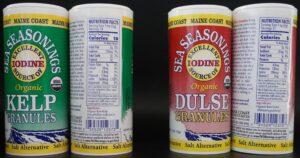In a recent email I discussed the critical importance of iodine for human health: Cayce on the Critical Importance of Iodine
Many people assume they’re getting all the iodine they need from salt. All things considered, iodized salt is pretty safe, and was considered acceptable in Edgar Cayce’s readings. But not all salt is iodized. While the sea has lots of iodine, “Sea Salt” has approximately ZERO micrograms iodine per serving. Furthermore, iodized salt has an expiration date: iodine added to salt gradually sublimes and drifts away. Depending on how long it’s been since a container was produced, a serving of “iodized salt” might only have a fraction of the iodine that it had originally.
Ideally a person would get all the iodine they need from diet. People whose diets contain dairy products (animal-derived, NOT “plant milks”) and egg yolks can assume they get the minimum amount of iodine necessary to keep their thyroid from enlarging. Adding seaweed to one’s diet is a good way to safely increase iodine intake. I found these two kinds of seaweed at my local natural foods store:

Kelp has almost 6 times as much iodine per teaspoon as dulse. I found some expired “roasted seaweed” products in my pantry – the oil on them has gone stale, and they’re now rather repulsive. I recommend avoiding any seaweed that has “vegetable oil” (sunflower oil, avocado oil, etc) on the ingredients.
The U.S. National Institutes of Health published Iodine: Fact Sheet for Health Professionals with values for the iodine content of common foods:
| Food | Micrograms per serving |
% daily value |
| Cod, baked, 3 ounces | 146 | 97 |
| Seaweed, nori, dried, 2 tablespoons, flaked (5 g) | 116 | 77 |
| Oysters, cooked, 3 ounces | 93 | 62 |
| Yogurt, Greek, plain, nonfat, ¾ cup | 87 | 58 |
| Milk, nonfat, 1 cup | 84 | 56 |
| Iodized table salt, ¼ teaspoon | 78 | 52 |
| Fish sticks, cooked, 3 ounces | 57 | 38 |
| Egg, hard boiled, 1 large | 31 | 21 |
Milk has 84 mcg of iodine, while “soy beverage” has 3 mcg. Other foods with negligible amounts (0 to 1 microgram) of iodine per serving include chicken breast, apple juice, bread, “sea salt”, rice, corn, broccoli, bananas, soy sauce, lima beans, green peas.
A healthy person eating an ‘okay’ diet needs a minimum of about 150 micrograms of iodine a day. People who eat diets with lots of vegetable oil would probably benefit from extra iodine. Japanese people get around 1000-3000 micrograms of iodine a day (source: Assessment of Japanese iodine intake). 1 milligram is 1000 micrograms, so this is 1-3 milligrams of iodine a day. This is probably the upper range for ‘safe’ daily iodine consumption.
An early iodine supplement that’s still sold today is Lugol’s formula. Iodine supplements can be useful, but too much iodine is toxic. The Jod-Basedow phenomenon is caused by a sudden overdose of iodine in a person who is iodine-deficient. One drop of Lugol’s 5% solution provides twice as much iodine as the Japanese get from their daily diet:
The (nominal) 5% solution thus has a total iodine content of 6.32 mg (6320 micrograms) per drop of 0.05 mL; the (nominal) 2% solution has 2.53 mg [2530 micrograms] total iodine content per drop
Large doses of iodine are useful when people need to rapidly saturate their thyroid with iodine on account of a nuclear accident they’re downwind from. The iodine that’s released in nuclear fission reactions is radioactive and is unstable. The thyroid can’t tell the difference between “safe” non-radioactive iodine and the radioactive iodine released from a nuclear reaction, which is why people in the vicinity of a nuclear accident are given potassium iodide tablets.
Most people don’t actually need a drop of Lugol’s daily. A drop of 5% Lugol’s a week would provide the equivalent of a Japanese-person’s food intake.
Safe Iodine Supplementation
The Electric Iodine supplement is formulated to have 200 micrograms per drop. Edgar Cayce’s readings provided for a variety of dosing strategies, based on the specific reading recipient’s individual needs.

The bottles have dropper caps. These are a little more difficult to dispense a precise number of drops than the bulb droppers, but I’m not the only one who has lost a bottle of liquid by accidentally allowing the bottle to tip over.